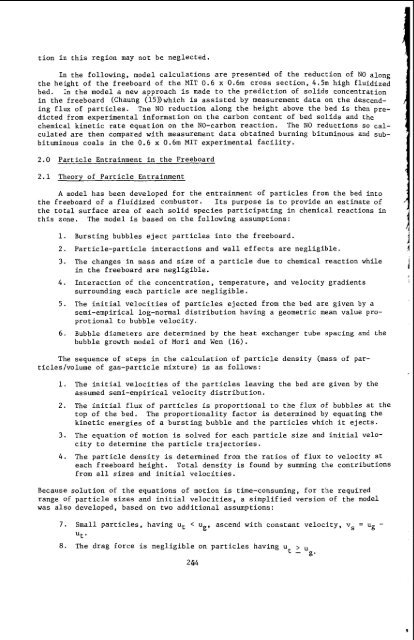the coking properties of coal at elevated pressures. - Argonne ...
the coking properties of coal at elevated pressures. - Argonne ...
the coking properties of coal at elevated pressures. - Argonne ...
You also want an ePaper? Increase the reach of your titles
YUMPU automatically turns print PDFs into web optimized ePapers that Google loves.
tion in this region may not be neglected.<br />
In <strong>the</strong> following, model calcul<strong>at</strong>ions are presented <strong>of</strong> <strong>the</strong> reduction <strong>of</strong> NO along<br />
<strong>the</strong> height <strong>of</strong> <strong>the</strong> freeboard <strong>of</strong> <strong>the</strong> MIT 0.6 x 0.6m cross section, 4.5m high fluidized<br />
bed. In <strong>the</strong> model a new approach is made to <strong>the</strong> prediction <strong>of</strong> solids concentr<strong>at</strong>ion<br />
in <strong>the</strong> freeboard (Chaung (15))which is assisted by measurement d<strong>at</strong>a on <strong>the</strong> descend-<br />
ing flux <strong>of</strong> particles. The NO reduction along <strong>the</strong> height above <strong>the</strong> bed is <strong>the</strong>n pre-<br />
dicted from experimental inform<strong>at</strong>ion on <strong>the</strong> carbon content <strong>of</strong> bed solids and <strong>the</strong><br />
chemical kinetic r<strong>at</strong>e equ<strong>at</strong>ion on <strong>the</strong> NO-carbon reaction. The NO reductions so cal-<br />
cul<strong>at</strong>ed are <strong>the</strong>n compared with measurement d<strong>at</strong>a obtained burning bituminous and sub-<br />
bituminous <strong>coal</strong>s in <strong>the</strong> 0.6 x 0.6m MIT experimental facility.<br />
2.0 Particle Entrainment in <strong>the</strong> Freeboard<br />
2.1 Theory <strong>of</strong> Particle Entrainment<br />
A model has been developed for <strong>the</strong> entrainment <strong>of</strong> particles from <strong>the</strong> bed into<br />
<strong>the</strong> freeboard <strong>of</strong> a fluidized combustor. Its purpose is to provide an estim<strong>at</strong>e <strong>of</strong><br />
<strong>the</strong> total surface area <strong>of</strong> each solid species particip<strong>at</strong>ing in chemical reactions in<br />
this zone. The model is based on <strong>the</strong> following assumptions:<br />
1. Bursting bubbles eject particles into <strong>the</strong> freeboard.<br />
2. Particle-particle interactions and wall effects are negligible.<br />
3. The changes in mass and size <strong>of</strong> a particle due to chemical reaction while<br />
in <strong>the</strong> freeboard are negligible.<br />
4. Interaction <strong>of</strong> <strong>the</strong> concentr<strong>at</strong>ion, temper<strong>at</strong>ure, and velocity gradients<br />
surrounding each particle are negligible.<br />
5. The initial velocities <strong>of</strong> particles ejected from <strong>the</strong> bed are given by a<br />
semi-empirical log-normal distribution having a geometric mean value proprotional<br />
to bubble velocity.<br />
6. Bubble diameters are determined by <strong>the</strong> he<strong>at</strong> exchanger tube spacing and <strong>the</strong><br />
bubble growth model <strong>of</strong> Mori and Wen (16).<br />
The sequence <strong>of</strong> steps in <strong>the</strong> calcul<strong>at</strong>ion <strong>of</strong> particle density (mass <strong>of</strong> par-<br />
ticles/volume <strong>of</strong> gas-particle mixture) is as follows:<br />
1. The initial velocities <strong>of</strong> <strong>the</strong> particles leaving <strong>the</strong> bed are given by <strong>the</strong><br />
assumed semi-empirical velocity distribution.<br />
2.<br />
3.<br />
The initial flux <strong>of</strong> particles is proportional to <strong>the</strong> flux <strong>of</strong> bubbles <strong>at</strong> <strong>the</strong><br />
top <strong>of</strong> <strong>the</strong> bed. The proportionality factor is determined by equ<strong>at</strong>ing <strong>the</strong><br />
kinetic energies <strong>of</strong> a bursting bubble and <strong>the</strong> particles which it ejects.<br />
The equ<strong>at</strong>ion <strong>of</strong> motion is solved for each particle size and initial velo-<br />
city to determine <strong>the</strong> particle trajectories.<br />
4. The particle density is determined from <strong>the</strong> r<strong>at</strong>ios <strong>of</strong> flux to velocity <strong>at</strong><br />
each freeboard height. Total density is found by summing <strong>the</strong> contributions<br />
from all sizes and initial velocities.<br />
Because solution <strong>of</strong> <strong>the</strong> equ<strong>at</strong>ions <strong>of</strong> motion is time-consuming, for <strong>the</strong> required<br />
range <strong>of</strong> particle sizes and initial velocities, a simplified version <strong>of</strong> <strong>the</strong> model<br />
was also developed, based on two additional assumptions:<br />
7. Small particles, having ut < ug, ascend with constant velocity, vs = ug -<br />
8.<br />
Ut'<br />
The drag force is negligible on particles having u<br />
t L ug.<br />
284

















